Which Of The Following Is Not A Major Factor Controlling Glacial Erosion?
The Forces that Change the Face of Earth
Despite our tendency to consider Earth as static, information technology is actually a dynamic and ever-changing planet. Air current, water, and ice erode and shape the country. Volcanic activeness and earthquakes change the landscape in a dramatic and oftentimes violent fashion. And on a much longer timescale, the movement of earth's plates slowly reconfigures oceans and continents.
Each one of these processes plays a role in the Arctic and Antarctica. We'll discuss each in general and specifically in the polar regions.
EROSION
Wind, water, and ice are the three agents of erosion, or the carrying away of rock, sediment, and soil. Erosion is distinguished from weathering — the concrete or chemical breakup of the minerals in rock. Notwithstanding, weathering and erosion can happen simultaneously. Erosion is a natural procedure, though it is oftentimes increased by humans' use of the land. Deforestation, overgrazing, construction, and route edifice oft expose soil and sediments and lead to increased erosion. Excessive erosion leads to loss of soil, ecosystem damage, and a buildup of sediments in water sources. Building terraces and planting copse can help reduce erosion.
GLACIERS
In the Arctic and sub-Arctic, glacial erosion has shaped much of the mural. Glaciers primarily erode through plucking and abrasion. Plucking occurs as a glacier flows over bedrock, softening and lifting blocks of rock that are brought into the ice. The intense pressure at the base of the glacier causes some of the ice to melt, forming a thin layer of subglacial water. This water flows into cracks in the boulder. As the water refreezes, the ice acts equally a lever loosening the rock by lifting it. The fractured rock is thus incorporated into the glacier's load and is carried forth as the glacier slowly moves.
Abrasion happens when the glacier's water ice and rock fragments act equally sandpaper, crushing the rock into finely grained rock flour and smoothing the rock below. Meltwater streams of many glaciers are grayish in color due to loftier amounts of rock flour.
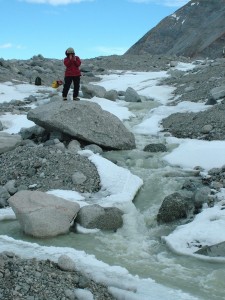
Above-freezing temperatures created a meltwater stream on the Scott Glacier, Antarctica. Photo courtesy of BlueCanoe (Flickr).
Glacial erosion is evident through the U-shaped valleys and fjords that are located throughout the Arctic and sub-Chill regions. Glacial moraines are formed every bit a glacier recedes, leaving backside big piles of rock, gravel, and fifty-fifty boulders. Moraines may form at the foot (terminal moraine) or sides (lateral moraine) of the glacier or in the middle of ii merging glaciers (medial moraine).
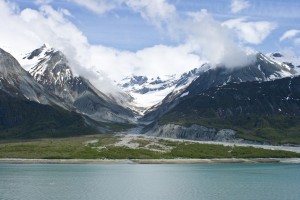
A U shaped Valley in Alaska.
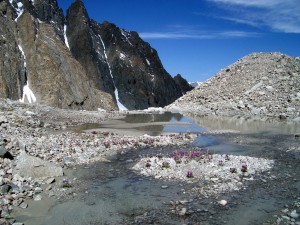
Glacial moraine in Kyrgyzstan.

A fjord in Norway.
Photos courtesy (T to B) of Skylar Primm, Geir Halvorsen, and Martin Talbot (Flickr).
Coastal erosion has become a major issue in contempo years in the Arctic, with Alaska's North Slope losing as much as thirty meters (100 anxiety) per yr! Climate alter is idea to be the underlying cause. As the climate warms and body of water ice melts, more of the sun'due south energy is absorbed by bounding main water. As this heat is transferred to the country, the permafrost (frozen soil) thaws, making the coast vulnerable to erosion from wave action and storms (which are more frequent due to warmer temperatures and open water). This video from the University of Colorado Boulder and the U.S. Geological Survey shows fourth dimension-lapse images during one month of aging.
WIND
In Antarctica, katabatic winds play a large office in erosion. This type of current of air occurs when high-density common cold air builds up at high elevations (on the ice sheets, for example) and moves downhill nether the strength of gravity.
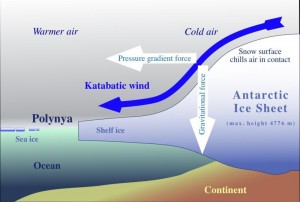
Image courtesy of Hannes Grobe, Alfred Wegner Institute for Polar and Marine Research (Wikimedia).
Katabatic winds in Antarctica and Greenland are intensely common cold and fast, ofttimes reaching hurricane speed. You can hear these trigger-happy winds in this YouTube video
The winds in Antarctica carry modest grains of sand that scour and erode the exposed rocks, resulting in unusual shapes and formations. These oddly shaped, eroded rocks are chosen ventrifacts.

Ventrifacts are wind-eroded rocks institute in the McMurdo Dry Valleys. They range from finger-sized to larger than houses. Photo courtesy of Kristan Hutchison, National Science Foundation.
PLATE TECTONICS
The theory of plate tectonics describes the motions of earth'south lithosphere, or outermost layer of hard, solid rock, over geologic time. Plate tectonics provides scientists with a keen deal of information nigh the polar region's by.

Tectonic plates. Paradigm courtesy of Wikimedia.
Globe'southward lithosphere is broken into 7 major and many pocket-size tectonic plates. These plates move in relation to each other, slowly irresolute the location of earth's continents and oceans.
Geological evidence from Antarctica supports the theory that North America and Antarctica were connected approximately one billion years ago in the global supercontinent Rodinia. The continents eventually broke apart, merging again approximately 200 meg years ago in the supercontinent Pangaea. Fossil evidence from this fourth dimension menses confirms that Antarctica was connected to Commonwealth of australia and South America and much warmer than it is today.
The movement of the tectonic plates also means that they are associated with much of the world'southward volcanic and seismic activity.
VOLCANOES
A volcano is merely an area where magma, or molten rock, from the earth'due south pall reaches the earth's surface, becoming lava. Most volcanoes occur at plate boundaries, where two plates are moving away (diverging) or together (converging). A few volcanoes like the Hawaiian Islands form from a hot spot, or a weak spot in world's crust, where magma forces its way to the surface.
Volcanic eruptions may be explosive (vehement) or effusive (passive), depending on the lava chemistry (amounts of silica and dissolved gases). Silica is a mineral establish in nature equally sand or quartz. High levels of silica mean very pasty (thick) lava, and low levels mean more than fluid lava. Dissolved gases build up inside the volcano, much similar a tin of soda or other carbonated beverage. The college the level of gas, the more pressure that builds – and the more than trigger-happy an explosion. The combination of silica and dissolved gas levels determines the type of eruption and shape of the volcano.
Volcanoes are classified into four types, based on their lava chemistry and shape.
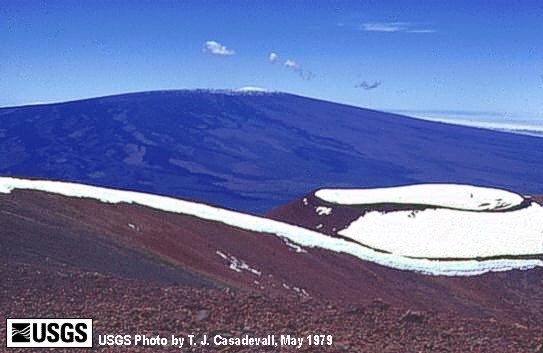 | Shield Volcano: A shield volcano has low levels of dissolved gas and silica in its magma. Its eruptions are effusive, and the very fluid lava moves quickly away from the vent, forming a gently sloping volcano. Mauna Loa in Hawaii is an example. |
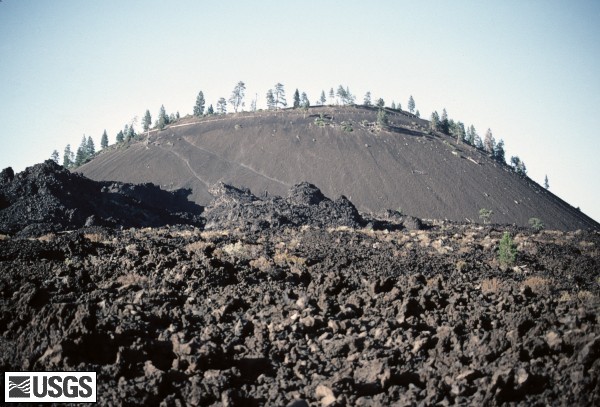 | Cinder Cone Volcano: A cinder cone volcano has low silica levels and loftier levels of dissolved gas, resulting in fluid lava that erupts explosively equally a result of the immense pressure built in the magma chamber. A cinder cone volcano erupts by shooting fountains of fiery lava high in the air, which cools and forms a steep-sided conical structure. Lava Butte in Oregon is an instance. |
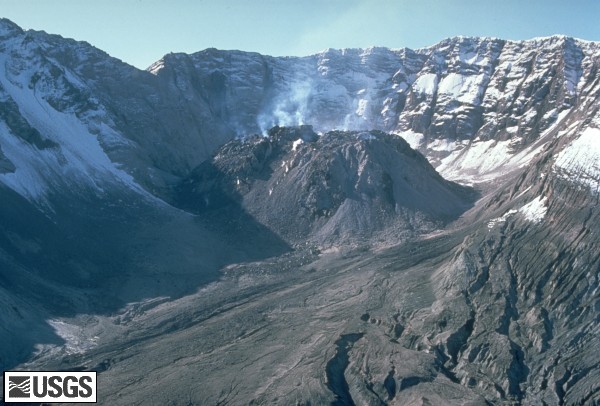 | Lava Dome Volcano: A lava dome volcano has high silica levels and depression dissolved gases in its magma. This results in effusive, gummy lava that forms a rounded, steep-sided mound. Lava domes are often created afterward an explosive eruption, which released much of the dissolved gas in the magma. The lava slowly continues to catamenia out of the volcano, forming a rounded, steep-sided mound. Since the 1981 eruption of Mt. St. Helens, a lava dome has been forming inside the crater of the volcano. |
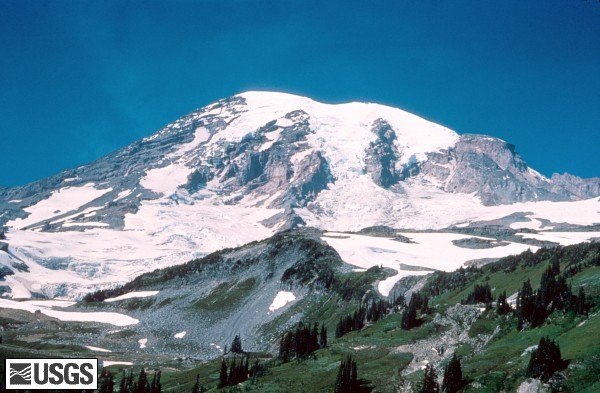 | Blended Volcano: A composite volcano has high levels of dissolved gas and silica and erupts explosively. Composite volcanoes often resemble steep-sided mountains earlier erupting. During tearing eruptions, it tin can seem as if the whole top of the mountain has been diddled off. Eruptions ofttimes include pyroclastic material (ash and lava fragments), leaving the volcano to collapse inward and course a crater. Mt. St. Helens and Mt. Rainier in Washington are examples. |
Images courtesy of the U.S. Geological Survey.
Largely unexplored, the Gakkel Ridge runs underneath the Arctic Ocean. Scientists take discovered volcanic craters and show of surprisingly violent eruptions in the contempo past.
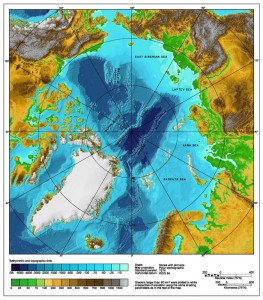
Map courtesy of the National Oceanic and Atmospheric Assistants.
Antarctica, too, is abode to volcanic activity. Ross Island, located in the Ross Bounding main, is equanimous of iii extinct volcanoes (Mt. Bird, Mt. Terror, and Hut Betoken) and Mt. Erebus, Antarctica's nigh agile volcano.

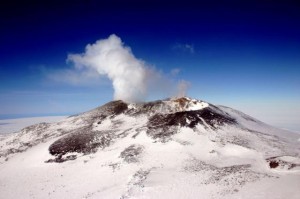
The acme of Mt. Erebus from the front end seat of a helicopter. Photograph courtesy of Mt. Erebus Volcano Observatory.
Mt. Erebus is dwelling to a permanent lava lake, or a large amount of molten lava contained in a crater. Only three volcanoes in the world accept permanent lava lakes, making Mt. Erebus an important research site for scientists looking to better understand the internal plumbing system of volcanoes. However, its location permits just a six-week field flavor and its high distance (3794 meters) is physically challenging.
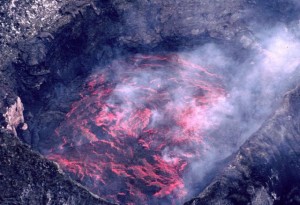
Mt. Erebus lava lake in 1983. Photo courtesy of Mt. Erebus Volcano Observatory.
Mt. Erebus is likewise notable for its persistent low-level eruptive activity (with almost daily eruptions). While the volcano has had some history of tearing activity, almost eruptions are passive lava flows similar to the volcanoes of Hawaii.
EARTHQUAKES
Seismic action (earthquakes) is most ofttimes associated with tectonic plate boundaries. As plates slowly movement, their jagged edges stick and suddenly skid, causing an earthquake.
The Gakkel Ridge underneath the Arctic Ocean experiences small earthquakes that back-trail the volcanic activity found in the surface area. Antarctica, which lies in the center of a tectonic plate, does non experience many earthquakes. Even so, seismic activity is associated with eruptions of Mt. Erebus.
RELATED RESOURCES
Use these resource to learn more about erosion, volcanoes, earthquakes, and plate tectonics and how these agents of change affect the polar regions.
All Most Glaciers
Learn how glaciers form, move, and shape the landscape.
Katabatic Winds
Basic information nearly the winds of Antarctica.
National Geographic: Forces of Nature
Explore volcanoes and earthquakes in this web site. Don't miss the interactive activities that permit you to most erupt volcanoes and trigger earthquakes!
Polar Discovery: Arctic Seafloor Trek
During summer 2007, a squad of scientists used autonomous underwater vehicles to explore the Gakkel Ridge. The Polar Discovery web site documents the expedition and provides background information, images, and video.
Mt. Erebus Volcano Observatory
Provides general data about Mt. Erebus, ongoing research, video, and a photo gallery.
National Scientific discipline Pedagogy Standards: Science Content Standards
The entire National Science Education Standards certificate can be read online or downloaded for free from the National Academies Press web site. The following excerpt was taken from Affiliate 6.
A study of changes in the Earth's surface aligns with the Earth and Space Scientific discipline, and the Scientific discipline in Personal and Social Perspectives content standards of the National Science Instruction Standards:
K-four World and Space Science: Changes in the Earth and Sky
- The surface of the earth changes. Some changes are due to tedious processes, such as erosion and weathering, and some changes are due to rapid processes, such as landslides, volcanic eruptions, and earthquakes.
five-eight World and Space Science: Structure of the World System
- The solid earth is layered with a lithosphere; hot, convecting mantle; and dense, metallic core.
- Lithospheric plates on the scales of continents and oceans constantly move at rates of centimeters per twelvemonth in response to movements in the drapery. Major geological events, such as earthquakes, volcanic eruptions, and mountain building, result from these plate motions.
- Land forms are the result of a combination of constructive and subversive forces. Constructive forces include crustal deformation, volcanic eruption, and deposition of sediment, while destructive forces include weathering and erosion.
5-8 Globe and Space Science: Earth's History
- The earth processes we see today, including erosion, movement of lithospheric plates, and changes in atmospheric composition, are similar to those that occurred in the past.
- Fossils provide important evidence of how life and ecology conditions have inverse.
K-4 Science in Personal and Social Perspectives: Changes in Environments
- Changes in environments can be natural or influenced by humans. Some changes are good, some are bad, and some are neither good nor bad.
- Some environmental changes occur slowly, and others occur apace.
5-8 Scientific discipline in Personal and Social Perspectives: Natural Hazards
- Internal and external processes of the earth system cause natural hazards, events that change or destroy homo and wild fauna habitats, damage belongings, and harm or kill humans.
This article was written by Jessica Fries-Gaither. For more data, see the Contributors page. Email Kimberly Lightle, Principal Investigator, with any questions about the content of this site.
Copyright December 2008 – The Ohio Land University. This material is based upon work supported by the National Scientific discipline Foundation nether Grant No. 0733024. Whatever opinions, findings, and conclusions or recommendations expressed in this material are those of the author(due south) and do not necessarily reverberate the views of the National Science Foundation. This piece of work is licensed under an Attribution-ShareAlike iii.0 Unported Creative Commons license
Which Of The Following Is Not A Major Factor Controlling Glacial Erosion?,
Source: https://beyondpenguins.ehe.osu.edu/issue/earths-changing-surface/the-forces-that-change-the-face-of-earth
Posted by: kennedyhimantand.blogspot.com


0 Response to "Which Of The Following Is Not A Major Factor Controlling Glacial Erosion?"
Post a Comment